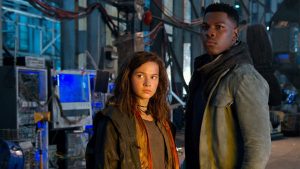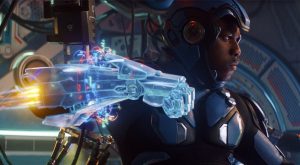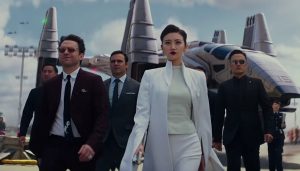![]()
The original Pacific Rim arrived as a modern take on Japanese monster movies, placing humans in giant robots called Jaegers and forcing them to combat an invasion of enormous Kaiju creatures from an interdimensional portal. It may not have been to everyone’s taste, but this reviewer enjoyed the eccentric imagination and visual inventiveness of filmmaker Guillermo Del Toro (The Shape of Water, Pan’s Labyrinth) run wild across the screen. This week sees the release of Pacific Rim: Uprising, a follow-up that features different people behind the camera, as well as a mostly new team onscreen.
 Set 10 years after the previous installment, the interdimensional portal that allowed the monsters entry has been closed. Many Jaegers have been decommissioned and the planet has begun to rebuild. The story follows Jake Pentecost (John Boyega), son of one of the deceased heroes from the previous installment, who is roped into training a new group of young recruits; most notably, a young girl named Amara Namani (Cailee Spaeny) who appears to be better equipped at building robots than most of the military experts on hand. As the pair come to grips with their new positions, the Shoa Corporation arrives, promoting their new drone robots, which they claim will protect the planet far more efficiently. Soon a new threat arrives, forcing the green recruits to suit up.
Set 10 years after the previous installment, the interdimensional portal that allowed the monsters entry has been closed. Many Jaegers have been decommissioned and the planet has begun to rebuild. The story follows Jake Pentecost (John Boyega), son of one of the deceased heroes from the previous installment, who is roped into training a new group of young recruits; most notably, a young girl named Amara Namani (Cailee Spaeny) who appears to be better equipped at building robots than most of the military experts on hand. As the pair come to grips with their new positions, the Shoa Corporation arrives, promoting their new drone robots, which they claim will protect the planet far more efficiently. Soon a new threat arrives, forcing the green recruits to suit up.
While the rating (PG-13) may be the same as the first movie, this installment seems strangely concocted to appeal exclusively to kids. The overall themes of discordant persons finding a way to become a team and work together are still present, but these characters are far less developed and are presented in a blunt and obvious manner. It doesn’t help that the protagonists are primarily teenagers this time out. As viewers, we all know that the exaggerated events are outrageous, but adding youngsters as the heroes makes the onscreen events seem all the more preposterous.
 The first two thirds of the film deal primarily with the Jaegers clanking and beating on each other. In fact, the big alien monsters and the grand, sinister plot doesn’t even come to fruition until the very final act. The largely CGI-action scenes themselves are reasonably well-handled, but there’s nothing onscreen that tops the original. And since the characters aren’t as well drawn or interesting, the battles themselves don’t appear nearly as tense or thrilling.
The first two thirds of the film deal primarily with the Jaegers clanking and beating on each other. In fact, the big alien monsters and the grand, sinister plot doesn’t even come to fruition until the very final act. The largely CGI-action scenes themselves are reasonably well-handled, but there’s nothing onscreen that tops the original. And since the characters aren’t as well drawn or interesting, the battles themselves don’t appear nearly as tense or thrilling.
 Boyega comes off best and tries to add a bit of levity to some of the stiff and awkward exposition. The screenplay also reunites the bickering scientists played by Charlie Day and Burn Gorman. They also attempt to liven things up (although one of them is directed to go far too over-the-top with their performance). Still, the movie takes its sweet time getting into gear and instead focuses on its corporate espionage subplot. The dialogue is particularly clunky as the youngsters either butt heads or attempt to explain the technology and plot details.
Boyega comes off best and tries to add a bit of levity to some of the stiff and awkward exposition. The screenplay also reunites the bickering scientists played by Charlie Day and Burn Gorman. They also attempt to liven things up (although one of them is directed to go far too over-the-top with their performance). Still, the movie takes its sweet time getting into gear and instead focuses on its corporate espionage subplot. The dialogue is particularly clunky as the youngsters either butt heads or attempt to explain the technology and plot details.
Overall, there’s a general tameness to the proceedings. This sequel feels like it was constructed by a group of studio heads attempting to evolve the franchise into something accessible to a wider variety of viewers. Sadly, the approach results in a bland final product. In fact, at times this reviewer couldn’t help but feel like he was watching an elaborate episode of the Mighty Morphin Power Rangers. The original film’s weird eccentricities actually helped it stand out, but Pacific Rim: Uprising ultimately comes across as an ordinary and unnecessary follow-up.


